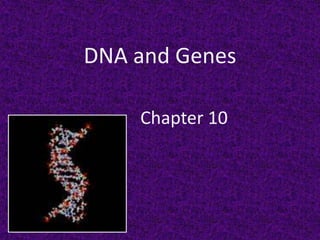
Dna history for online
- 1. DNA and Genes Chapter 10
- 3. Frederick Griffith (1928) • Studied pneumonia bacteria, Streptococcus pneumoniae. It has 2 strains, “smooth” (S) and “rough” (R). These traits were inherited by the bacterium. • His studies of pneumonia bacteria showed that "something" had caused the R strain to be transformed into the S strain
- 5. Conclusion: Conclusion: Conclusion: Conclusion: Encapsulated strain without Polysaccharide R strain cells strain is polysaccharide coat did not had acquired pathogenic is non- cause the ability to pathogenic pneumonia make polysaccharide coats from the dead S cells and this trait was inheritable
- 6. • This phenomenon is known as transformation--change in phenotype due to the assimilation of externally acquired genetic material. • From these experiments the nature of the inheritable material could not be determined.
- 7. • By the 1940's, it was understood that chromosomes carry the heritable material. • At this time little was known about DNA other than it was fairly uniform and thought to be uniform throughout. • Proteins were thought to be not uniform and to have a great deal of functional specificity. • For these reasons, many scientists thought protein was likely to be the genetic material.
- 8. Hershey & Chase (1952) • Studied bacteriophages ("bacteria eaters'' viruses that infect bacteria), which are composed of a DNA core and a protein coat
- 9. Phage attaches Phage injects DNA. Phage DNA directs host to bacterial cell. cell to make more phage DNA and protein parts. New phages assemble. Cell lyses and releases new phages. • Bacteriophages attach themselves to the surface of a bacterium and inject their DNA into the bacterium • Phages were labeled with radioactive phosphorus to detect DNA
- 10. • They had successfully used radioactive labeling to provide evidence that DNA was the transforming factor for Griffith’s work
- 11. Rosalind Franklin & Maurice Wilkins (early 1950's) • made X-ray crystallography photographs of DNA to learn its structure
- 12. Erwin Chargaff (1950) • An American biochemist (1905-2002) • He demonstrated 3 rules about DNA structure
- 13. • Chargaff's Rules, which state that in DNA: 1.The number of adenine (A) residues always equals the number of thymine (T) residues 2.The number of guanine (G) residues always equals the number of cytosine (C) residues 3.The number of purines (A+G) always equals the number of pyrimidines (T+C) — this rule is an obvious consequence of rules 1 and 2.
- 14. • He also showed that these rules hold true even though the ratio (G+C):(A+T) varies from one type of organism to another. • Two years later he explained these findings to James Watson and Francis Crick.
- 15. Watson & Crick 1953 • Used Chargaff’s discoveries and Rosalind Franklin’s X-ray crystallography pictures to deduct the double-helix model of DNA.
- 16. Methods used to observe DNA
- 17. Chromosome Smear – stain of the chromosomes in a human cell:
- 18. KARYOTYPE • Takes chromosomes from chromosome smear and arrange them by size and grouped into homologous pairs. • Homologous chromosomes have genes for the same traits arranged in the same order
- 20. Predict what the karyotype of a normal male would look like?
- 21. Genes a segment of DNA on the chromosome responsible for the production of one protein human cell contains 50,000 to 100,000 genes
- 22. Gene Mapping – tells what each segment (gene) of the chromosome codes for.
- 23. Gel Electrophoresis – Mix DNA with restriction enzymes, which break the DNA into fragments that are then stained. Then put fragments into a gel and introduce electricity. The DNA fragments are separated according to size.
- 24. The Breakdown of DNA: The Molecule of Heredity
- 25. Prokaryote DNA • DNA in prokaryotes, such as bacteria, is circular and called plasmids. • There can be several plasmids inside the cell. • The plasmids are accompanied by a single chromosome located in the cytoplasm.
- 26. E. coli Bacteria
- 27. Eukaryote DNA DNA is contained in the chromosomes which are located in the membrane- bound nucleus.
- 28. Chromosomes are composed of many, many genes, which are composed of long DNA strands.
- 29. Chromosome Structure of Eukaryotes Chromosome Nucleosome DNA double helix Coils Supercoils Histones